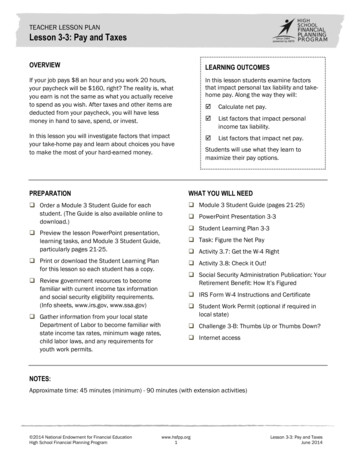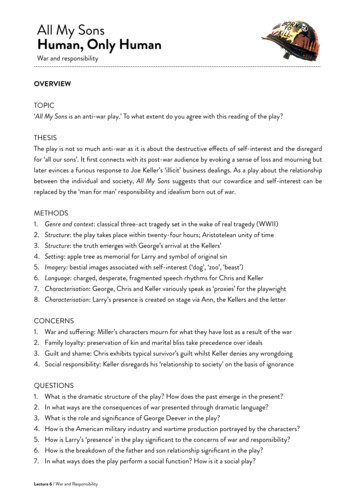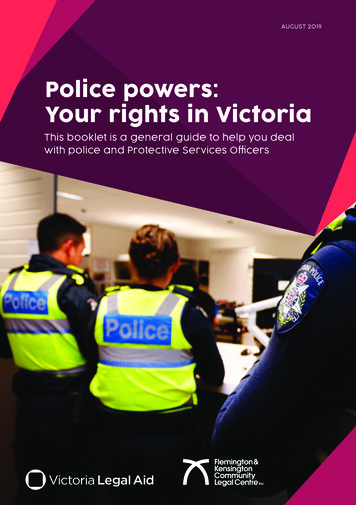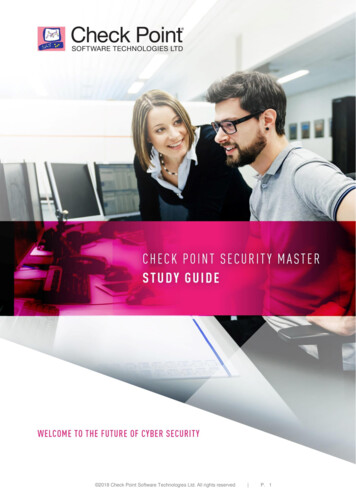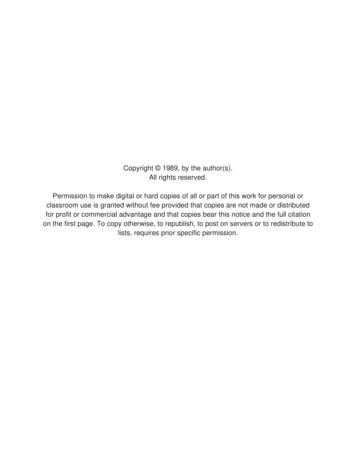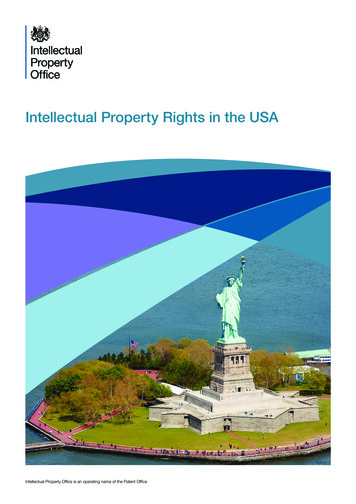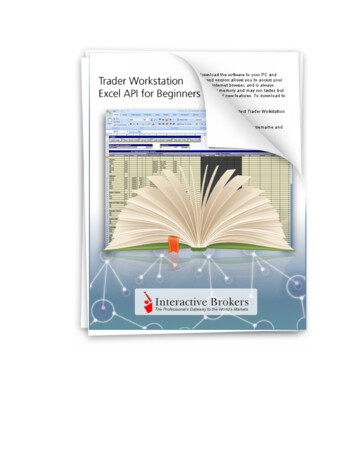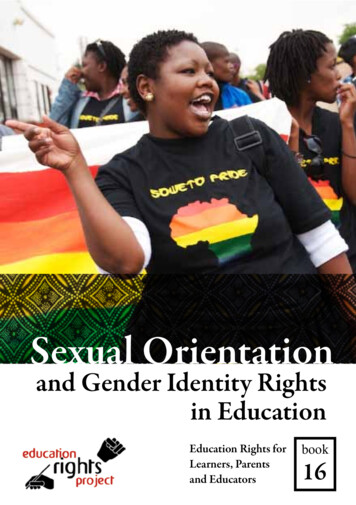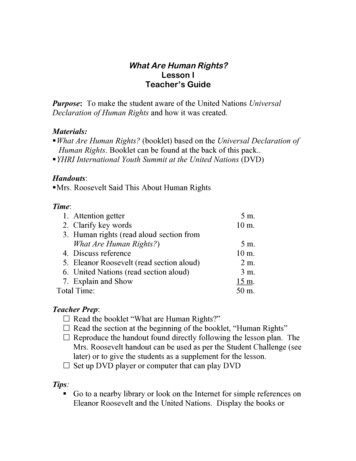
Transcription
What Are Human Rights?Lesson ITeacher’s GuidePurpose: To make the student aware of the United Nations UniversalDeclaration of Human Rights and how it was created.Materials: What Are Human Rights? (booklet) based on the Universal Declaration ofHuman Rights. Booklet can be found at the back of this pack. YHRI International Youth Summit at the United Nations (DVD)Handouts: Mrs. Roosevelt Said This About Human RightsTime:1. Attention getter2. Clarify key words3. Human rights (read aloud section fromWhat Are Human Rights?)4. Discuss reference5. Eleanor Roosevelt (read section aloud)6. United Nations (read section aloud)7. Explain and ShowTotal Time:5 m.10 m.5 m.10 m.2 m.3 m.15 m.50 m.Teacher Prep: Read the booklet “What are Human Rights?” Read the section at the beginning of the booklet, “Human Rights” Reproduce the handout found directly following the lesson plan. TheMrs. Roosevelt handout can be used as per the Student Challenge (seelater) or to give the students as a supplement for the lesson. Set up DVD player or computer that can play DVDTips: Go to a nearby library or look on the Internet for simple references onEleanor Roosevelt and the United Nations. Display the books or
printed matter in your classroom. Picture books are best for attractivedisplays and for inviting your students to explore further.
What Are Human Rights?Lesson ILesson PlanPresent each part of the lesson plan in the following order.Attention Getter (5 min.):Read the following story about a young girl who is a human rights advocate.Be sure to clarify the word advocate in the first sentence. Before starting,show the students where Tibet and China are on a globe or map. Tell themyou will be talking about these two countries. Use this story to attractinterest and get the students involved in the lesson to follow.A Young Girl Teaching Human RightsClaire Kevitt is a 14-year-old human rights advocate (an advocate is a personwho supports or speaks in favor of something). Claire is the Youth President of a specialgroup called Youth for Human Rights International.She has spoken at important meetings where adults are examininghuman rights issues.One time, she and her friends rode their bicycles for five days andmany miles all around the big city of Los Angeles, where they live. Alongthe way, they met with school children, local leaders and journalists (reporters,writers, or editors of news stories for newspapers, magazines, radio and television). Claire and herfriends taught the children who they met about human rights and askedpeople to sign a pledge of support for human rights.Claire has spoken to many classrooms full of children, to explain whathuman rights are and get young people learning their human rights.Claire has even traveled to the United Nations in New York (the UnitedNations is an organization composed of many countries who have agreed to work toward peace and humanrights for all people) totalk with other young people and adults about educationalsolutions to the human rights problems facing people around the world.She works on these projects with the help of young members of Youthfor Human Rights International.Claire started working for human rights when she was six years old.Her parents took her to a movie called Seven Years in Tibet. It was about thegentle religious leader of Tibet who had to leave his home and his countrybecause of war with its neighbor, China. Claire wanted to find out moreabout the true story of the leader, who is called The Dalai Lama. She askedher parents to read books to her about the Dalai Lama. Then she wrote theDalai Lama asking what she could do to help him return to Tibet. Her
mother helped her write the letter and the Dalai Lama replied, suggesting shewrite some more letters to certain leaders and groups. She did what hesuggested and was very happy to help him. She’s been a human rightsadvocate ever since.Does Claire seem different from you? Well, we are all different fromeach other and that’s what makes it so fun to get to know each other. Wealso have many similarities. Actually, every one of you is capable ofhelping with human rights, just as Claire does.Besides Claire’s human rights work, she goes to school, has hobbies,plays sports, goes places with her friends, laughs at silly jokes, plays thepiano, and does chores at home. What is remarkable about Claire is thathuman rights is very important to her. It is something she thinks about andworks on nearly every day.-End of StoryClarify Vocabulary (10 min.): Rights- claims or freedoms to be, do, or have something. His rights areprotected by law. Human- having to do with a person or persons. Men, women, andchildren are human beings. Declaration- the act of announcing or making something known; adocument showing that those that signed it are showing theiragreement with certain ideas. He signed the declaration yesterday. Universal- of, for, or shared by all. The need for food is universal.Read aloud to the students (5 min.):What Are Human Rights? page 2, section titled “What are Human Rights?”Be sure to clarify, as you go along, any words the students might notunderstand.Discussion Questions (10 min.): What are human rights? Can you give examples? What do human rights have to do with you?
Read aloud to the students (2 min.):Eleanor RooseveltEleanor Roosevelt (1884-1962) was the wife of Franklin D.Roosevelt, president of the United States during World War II. World War IIbegan in September 1939 and ended six years later, in September 1945.President Roosevelt died just before the end of the war. Mrs. Rooseveltworked very hard to make things better for people—especially youngpeople—while her husband was President and she continued her work afterhe died. When the war was over, Mrs. Roosevelt was asked to join the newUnited Nations as a delegate (delegate: someone who represents his group at an importantmeeting or for an important project) from the United States. Mrs. Roosevelt becamethe main writer of the United Nations Universal Declaration of HumanRights.Read aloud to the students (3 min.):What Are Human Rights?, page 3, section titled “About the United NationsUniversal Declaration of Human Rights”.Explain and Show (5 min.): The United Nations building is located in New York City (show map). The purpose of the United Nations is to work for peace among thenations of the world through communication, peaceful negotiationsand betterment of the human condition through human rights. Show a picture of the UN (from encyclopedia or internet). Play DVD “YHRI International Youth Summit” (10 minutes)Student Challenge (Optional): Give the students the handout titled “Mrs.Roosevelt Said This About Human Rights”. Challenge the students to read itand learn by heart this part of the quote, “Where, after all, do human rightsbegin? In small places close to home – so close and so small that theycannot be seen on any maps of the world.” This will be a recurring themethroughout these lesson plans. Ask them to recite this in the next lesson andwhen they do, you might want to offer the students who take up thischallenge, an extra privilege, sticker, reward or any other small extra treat ofsome kind that they would appreciate.End of Lesson
Lesson I HandoutMRS. ROOSEVELT SAID THIS ABOUT HUMAN RIGHTS“Where, after all, do Universal Rights begin?“In small places, close to home – so close and so small that they cannot beseen on any maps of the world. Yet they are the world of the individualperson; farm or office where he works. Such are the places where everyman, woman, and child seeks equal justice, equal opportunity, equal dignitywithout discrimination. Unless these rights have meaning there, they havelittle meaning anywhere. Without concerned citizen action to uphold themclose to home, we shall look in vain for progress in the larger world.”Vocabulary:In vain-without success, not accomplishing what is intended; He searched forhis shoe in vain.Citizen-a person who has a right to live in a country because he was bornthere or because he has been accepted with full rights in that country. I am acitizen of France.Discrimination- an unfair difference in treatment; denying equal rights tocertain groups of people. That company hires people without discrimination; theyhire based on ability.
Dignity-a proper sense of pride and respect. Their mother kept her dignity,despite being very poor.Equal -having the same rights and opportunities as others. Both the girls havean equal chance to enter the tennis competition.Opportunity-a good chance; a situation that will help achieve a goal ordesire. The boy has an opportunity to learn how to play football.Justice-being fair and right, especially in the way decisions are made inapplying rules or the law. The man asked for justice when lies were printed abouthim in the paper.Article-a section of a document that deals with a particular point. There arethirty articles in the Universal Declaration of Human Rights.Seeks -to try to find; to try. She seeks a faster way to wash the clothes.Student Challenge:Memorize the first two sentences of the above quote, “Where, after all, doUniversal Rights begin? In small places, close to home – so close and sosmall that they cannot be seen on any maps of the world.” Say thesesentences to another student until you know them perfectly.
What Are Human Rights?Lesson IITeacher’s GuidePurpose: To help students understand what is meant by “We are all Freeand Equal” and to respect differences.Materials: What Are Human Rights?(booklet) UNITED (DVD)Handouts: Free and Equal SurveyTime:1. Attention getter2. Clarify key words3. Human Right 1--read aloud4. Discussion5. Demonstration6. Activity7. Show DVDTotal Time:5 m.5 m.2 m.13 m.5 m.10 m.5 m.45 m.Teacher Prep: Read Human Rights Article 1 on page 2 of the booklet and also readthe unabridged version in the back of the booklet. Copy the template for the “shape badges” on three different colors ofcard stock so that there are a small variety of colors for each badgeshape. If you don’t have card stock, use the paper you have. Cutthem out. Make 10 more than the number of students, as you willneed some extras. Reproduce the handouts, which can be found directly following thelesson plan. Set up a DVD player or computer with DVD.Tips: When it’s time to read aloud a new human right, let a student read it.Choose a different student each time.
At the beginning of each discussion set some ground rules. To controlyour time, state to the students that you will be asking some questionsand you will only call on two or three people and get their agreementabout this. By laying the discussion ground rules first, and thenfollowing through, you will have more cooperation when it’s time tomove on and the lesson can go more quickly. The “shape badges” for the Demonstration and Activity are meant tobe graphic and distinct, therefore the lesson will be more clear to thestudent, if you make the badge set from the template, per above.If, however, you are not able to make the cards as provided, there areeasy substitutions you can make: have the students help you foldbadges into three distinct shapes from a piece of paper or material. Ifthis is not feasible, name a feature of clothing and group students byclothing types, such as “all students with short sleeves” in one group.You simply need to set the students up so that they can be grouped bysimilarities, using some token identifier; yet each token representingthe student is different nonetheless.
What Are Human Rights?Lesson IILesson PlanPresent each part of the lesson plan in the following order.Attention Getter (5 min.):1. Have geometric shapes of different colors ready to go. (See templateand instructions provided.) These will become “badges”.2. Pass them out, making sure there are a variety of shapes and colorshanded out randomly.3. Ask the students to draw a quick picture or write something on theirshape (see how fast they can do this —they have no more than 2minutes!). Tell them to make it their own and do not show theirclassmates until everyone is finished. This makes them investsomething personal in their badges, which gives the lesson moreimpact.4. Use straight pins, safety pins, paperclips or tape to affix the shape totheir shirts where it is easily seen.5. Important: Make it playful and mysterious! Do not answer anyquestions about why you did this. Just let them know they will soondiscover why.Vocabulary (5 min.): Free- not under another’s control; being able to move or act withoutbeing held back. The woman was free to learn how to drive. Equal- having the same rights and opportunities as others. The menhad an equal chance to apply for the job.Read aloud to the students (2 min.):What Are Human Rights?, page 4, Human Right 1, “We are all free andequal.”Discussion Questions (13 min.):1. We all have unique and wonderful qualities (“quality” means any of the featuresthat make a thing what it is; that helps you know it from other things). Who do you knowwith an unusual quality that you admire?
2. We all have different abilities in different areas. Name two peopleoutside of this classroom. Identify a different ability each one has.(Do not let the students name an inability. Keep it positive.)3. Is anyone exactly the same? (Get agreement that no one is exactly thesame.)4. Remember what the word “equal” means? (Review the word). Isanyone exactly equal? (Establish agreement that no one is exactlyequal.)5. What is the difference between “being equal” and “having equalrights”?Demonstration (5 min.):1. Briefly review the word “free”.2. Using the geometric-shaped badges you made from the templateprovided, hold up one of each shape. Color doesn’t matter.3. Have a student come to the front of the class.4. Let him choose one of the shapes. Tell him it is his decision to choosewhich he wants. Make sure he’s certain about his choice.5. Ask the other students, “Did (student) harm anyone and cause a badeffect, br
The United Nations building is located in New York City (show map). The purpose of the United Nations is to work for peace among the nations of the world through communication, peaceful negotiations and betterment of the human condition through human rights. Show a picture of the UN (from encyclopedia or internet). Play DVD “YHRI International Youth Summit” (10 minutes) Student


